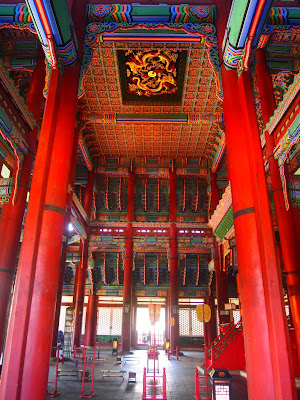Day 1 was a simple day with not much activities packed, as we had just arrived and were pretty tired from the overnight flight. Places visited were near the hotel, which also serve its purpose of familiarising us with the nearby area.
Gyeongbokgung is one of the remaining 5 palaces in Seoul, and is the largest out of them all. Korea seems to name its palaces by their location, such as Eastern Palace (Changdeokgung), Western Palace (Gyeongheegung), and the Northern Palace (Gyeongbokgung). Gyeongbokgung is also said to be the largest and most beautiful and grandest out of all the palaces that remain.
Based on Wikipedia, it was built in 1935 and was the main royal palace of the Joseon dynasty. Not only did it serve as the home of the Kings of the Joseon dynasty, it also housed the Kings' households and the government of Joseon. I believe the government back then was split into 2 arms, the legislative and executive, for we saw 2 buildings next to each other named as such.
The throne hall, where the King 'granted audiences to his officials, gave declarations of national importance, and greeted foreign envoys and ambassadors'
[Quoted from Wikipedia]
Glimpses of the interior of the 勤政殿, very intricate and detailed designs.
The design somehow reminds one of traditional Chinese palaces too, doesn't it? Not that I am a loyal supporter of the Chinese or anything, but I do believe that throughout history, Chinese did wield a considerable influence over Asia and its neighbouring countries, such as Japan and Korea. One, the language. Both languages somehow have some characters based on Chinese characters; for Japanese you have the Kanji, for Korean, using this as an example, names of buildings. Both languages also have pronunciation that are very similar to the words' Chinese pronunciation. Two, the colours and design. The colours red and gold is very striking, both of which are the usual colours for Chinese palaces. Or perhaps it is just an Asian thing to incline towards these colours?
A peek into the study room of the royals in the past; it looks exactly like what you see in Korean dramas featuring past dynasties.
The palace compound is very, very huge indeed...
And oddly, vegetation and flora and fauna are practically non-existent in the areas that we covered. The lack of a shade was exacerbated by the good weather - the sun was beating down mercilessly that day. We deduced the reason for the ground to be sand could possibly be due to the usage of horses during that time.
We managed to visit the Gangnyeongjeon (King's Quarters), Geunjeongjeon (Throne Hall), Gwanghwamun (main gate), Gyotaejeon (Queen's Quarters), Jagyeongjeon (Quarters of King's mother), and Sajeongjeon Hall. Pity that we did not manage to visit the Gyeonghoeru (Royal Banquet Hall), Hyangwonjeong Pavilion, and the Jibokjae (Private Royal Library). As all the structures in the buildings looked the same, we figured our way around by reading the information stands available and by eavesdropping on tour groups whose guide was speaking loud enough in a language that we understand (mainly Mandarin). The information stands were very brief, so if one really wants to understand and appreciate the history of the palace, it will be better to go for a guided tour.
The palace still conducts the changing of guards today, a programme that is worth catching.
The Cheonggyecheon Stream is a man-made project by the government, transformed into the perfect respite in the midst of the city with flora, fauna, and a flowing stream. It was undertaken as one of the efforts for urban renewal, reintroduce nature into the city, and restore history and culture of the region. It starts at the Cheonggye Plaza and runs past 'Deoksugung Palace, Seoul Plaza, the Sejong Center, Insa-dong Street, Changdeokgung Palace, and Changgyeonggung Palace, allowing visitors to easily visit major tourist sites after a leisurely stroll along the stream'. [Extracted from VisitKorea'].
The stream seems to be a popular place for both tourists and locals. As we walked along the stream, we can see many locals sitting down in groups, chatting away while eating take-away dinners. The walls lining the path also has many historical paintings on it, explaining some of the Korean culture back in the past. A good effort by the government, but it is not very eye-catching, so one may easily just take it as some decorative artwork.
This waterfall marks the beginning of the stream
We enjoyed walking down the stream, because it provided a cooling respite from the hot weather in the day, and it gives a breather from the bustling city from above. A must-visit, if you ever visit Korea!



















No comments:
Post a Comment